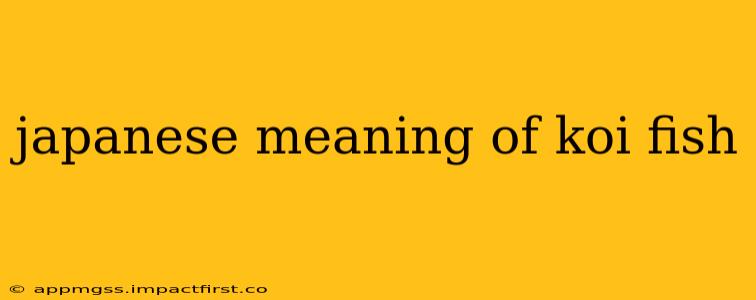Koi fish, with their vibrant colors and graceful movements, are more than just ornamental pond dwellers in Japan. They hold deep cultural significance, representing various positive attributes and embodying powerful symbolism. Understanding the Japanese meaning of koi goes beyond simply appreciating their beauty; it's about appreciating the rich history and tradition they represent.
What does Koi symbolize in Japanese culture?
In Japanese culture, koi are primarily associated with persistence, perseverance, and strength of purpose. Their legendary upstream swim against strong currents, particularly in the Yellow River, symbolizes overcoming obstacles and achieving one's goals. This unwavering determination resonates deeply within Japanese philosophy and aesthetics.
Beyond perseverance, different colors of koi carry specific symbolic meanings:
- Red Koi: Represents love and passion, often associated with relationships and romantic feelings.
- Black Koi: Symbolizes overcoming adversity, strength, and masculinity.
- White Koi: Represents purity, innocence, and sometimes, even spiritual growth.
- Yellow Koi: Represents wealth, prosperity, and good fortune.
- Blue Koi: Symbolizes fertility and abundance.
What is the legend of the Koi fish?
The most famous legend surrounding koi is the Dragon Gate legend. This ancient Chinese legend tells of carp attempting to swim upstream to a mythical Dragon Gate. Those who successfully reach the top transform into magnificent dragons, symbolizing transformation, ambition, and the achievement of extraordinary goals. This legend is deeply ingrained in Japanese culture and further strengthens the koi's association with perseverance.
Are Koi fish a good luck symbol?
Yes, koi fish are widely considered a symbol of good luck and prosperity in Japanese culture. Their resilience and determined nature make them auspicious symbols for achieving success and overcoming challenges. The different colors of koi further amplify these positive connotations, with each color offering its own specific blessing.
What is the difference between Koi and carp?
While koi are technically a type of carp ( Cyprinus carpio), they are specifically bred for their vibrant coloration and ornamental qualities. They are not found in the wild in their diverse array of colors. The term "koi" refers to these domesticated, colorful carp, distinct from their wild counterparts.
How are Koi fish used in Japanese art and design?
Koi are frequently depicted in Japanese art, including paintings, pottery, and textiles. Their elegant forms and striking colors make them popular subjects, often used to express themes of perseverance, beauty, and good fortune. They are also frequently incorporated into garden designs, symbolizing a tranquil yet powerful presence.
What is the spiritual meaning of Koi fish?
Beyond their cultural symbolism, some view koi as holding a spiritual significance, representing personal growth, inner strength, and the ability to overcome life's challenges. Their journey upstream mirrors the spiritual path of self-discovery and transformation.
In conclusion, the Japanese meaning of koi fish extends far beyond simple aesthetics. They are powerful symbols of perseverance, good fortune, and the transformative power of overcoming adversity. Understanding their cultural significance allows for a deeper appreciation of their beauty and the rich history they represent.
